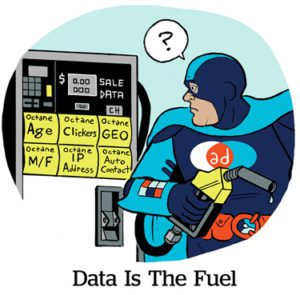Although broadcasters have been busy testing alternate currencies since Nielsen lost its accreditation for local and national ratings in 2021, Nielsen was still center stage during the 2022 upfronts.
“Right now, we’re just talking,” Andrea Zapata, EVP of ad sales, research and measurement insights at Warner Bros. Discovery (WBD), told AdExchanger at CES in Las Vegas last week.
But 2023 could be the year the TV industry moves from talking about and testing new measurement currencies to actually using them.
Transacting real dollars against new currencies during the upfronts is the industry’s “next heavy lift” for measurement this year, Zapata said.
WBD, for example, which is banding together with other broadcasters, including NBCUniversal, to develop alt currency standards in time for the 2024 upfronts, plans to already start transacting against “non-incumbent measurement partners” (i.e., providers not named “Nielsen”) during this year’s upfronts.
NBCUniversal also expects to transact hundreds of millions of dollars against alt currencies during the 2023 upfronts, which should surpass last year, when 40% of its upfront transactions were done through currencies alternative to Nielsen, said Kelly Abcarian, NBCU’s EVP of measurement and impact, speaking during a panel at CES.
The industry is in a hurry to move beyond Nielsen as a single currency, but broadcasters have been taking their time to “test and learn” in order to create a solid foundation for measurement as they move away from traditional demos and embrace big data sets.
But panels aren’t dead. Expect publishers to focus more on automatic content recognition (ACR) data, calibration panels and advanced audiences.
ACR-you ready?
Even Nielsen agrees that audience panels are outdated as the data source to support a standalone currency.
“Nielsen’s panels can’t enumerate measurement in a [streaming] world,” said Deirdre Thomas, managing director of Nielsen’s US audience measurement business development and sales, also speaking at CES.
The need for cross-platform measurement is why Nielsen is moving toward impression-based measurement. The company is launching the first version of its new cross-platform measurement platform, called Nielsen ONE, on January 11.
But while Nielsen toils to keep its crown, it’s now one of many currencies, as its competitors gain ground with new types of big data, including census-level device data.
Measurement and currency providers, for example, are clamoring for ACR data, which can track individual smart TV viewership and tie ad exposures to specific business outcomes.
“Now that we’re not beholden to one measurement currency anymore,” Zapata said, “we can actually use set-top box and ACR data to target [and measure] advanced audience segments beyond the upper funnel, down to conversion.”
WBD recently named VideoAmp as its newest measurement partner. VideoAmp typically uses ACR to report in-program viewership fluctuations for advertiser campaigns. And in November, iSpot.tv led a venture capital investment in TVision, which uses ACR as part of its attention measurement methodology, and Samba TV acquired an AI startup called Disruptel that uses ACR to identify content and actors on-screen.
What’cha watchin’?
There’s no question that measurement and currency providers have set their sights on ACR.
But industry executives hedged when asked about the privacy implications of ACR data.
“ACR won’t be a big issue, as long as there’s consent,” Zapata told AdExchanger.
And ACR isn’t the only show in town.
“There’s plenty of other first-party data besides ACR that requires consent,” said Claudio Marcus, VP of strategy at Comcast, on stage at CES.
Still, there are very real privacy concerns that broadcasters need to contend with. Not only is there debate as to whether smart TV tracking opt-ins count as informed consent, but ACR also carries a special risk because it can potentially link viewership history to an individual. Doing so without proper consent is illegal under the Video Privacy Protection Act (VPPA), which is the main reason why CTV publishers refuse to share show-level data in the bid stream.
(Alleged VPPA violations were also the basis for a case brought by the FTC over smart TV data collection, which was settled in 2017, and a class action lawsuit in California settled the following year.)
Makes sense why CTV providers are busy building clean rooms to mitigate the risks of data sharing.
But, although alternative measurement is all about big data, that doesn’t mean panels have no role to play, Zapata told AdExchanger.
Panels can be calibrated using big data sets to correct inaccuracies and bias, she said, while also providing a better idea of who within a household is being exposed to an ad.
VIZIO and the Video Advertising Bureau (VAB) both created “calibration panels” last year.
VIZIO is building its calibration panel using its own ACR data from Inscape, which it matches with third-party IDs to determine optimal reach and frequency for specific campaigns by population (such as, say, Black or Asian Americans) based on viewership at the household level.
The VAB, meanwhile, is using its panel to “personify” an impression within a household by matching ACR data with a panel provider, such as TVision or Kantar.
The ability to measure co-viewing is why iSpot recently invested in TVision, said Sean Muller, CEO of iSpot, speaking on stage at CES.
But, just like with the rise of alternative currencies, the new hype around calibration panels could result in a glut. Competition is healthy for the ecosystem, but too much of a good thing can become a bad thing.
The industry wants multiple alt currencies to form a measurement standard, but, as for calibration panels, there should probably only be a couple, Zapata told AdExchanger.
But regardless of the mix of data that publishers rely on, the common thread is an increased focus on advanced audiences.
The term “alt currency” connotes a shift away from ratings based on GRPs and basic demos. But just because publishers are testing alternates to Nielsen doesn’t mean they aren’t still using demos for measurement.
Compared with demos, advanced audiences are still only “a tiny portion” of the TV buying marketplace,” iSpot’s Muller said, although “currently most transactions using alternate currencies are against advanced audiences.”
But agencies are quickly making changes in order to take full advantage of streaming. “The buy side is leaning in more and more to advanced audiences,” Zapata said.
Any viable TV measurement solution will need to be able to toggle between both advanced and demo audiences, which is what Nielsen aims to do with ONE Ads, Nielsen’s Thomas said.
It’s still too early to say how different currencies will compete against each other during this year’s upfronts – or where exactly Nielsen ONE will fit into that picture.
But between upending panels and weaning off of demos, 2023 could be the year the TV industry finally moves measurement out of its comfort zone.




















